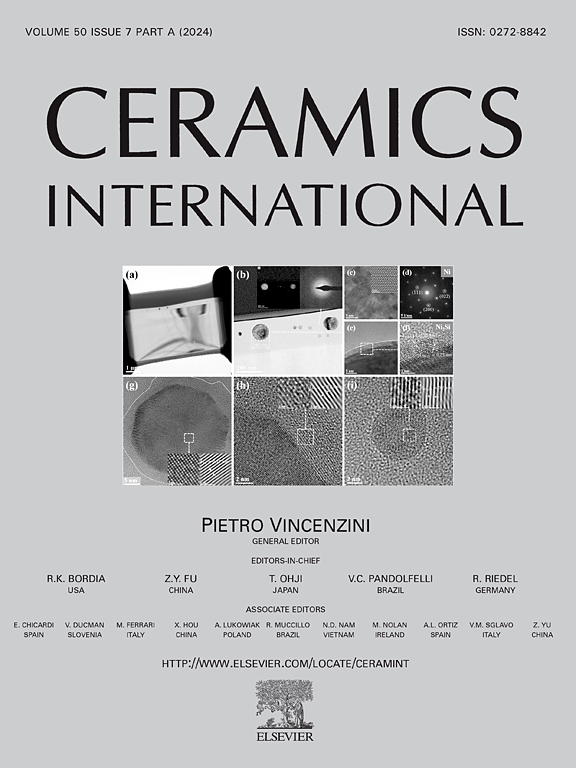沉积温度对本征CVD-SiC微观结构和电阻率的影响
IF 5.1
2区 材料科学
Q1 MATERIALS SCIENCE, CERAMICS
引用次数: 0
摘要
CVD体SiC广泛应用于等离子体刻蚀设备的腔室部件,如聚焦环等。在不同的蚀刻工艺下,CVD SiC聚焦环的电阻率要求不同,相差7-8个数量级。本研究在1250°C、1350°C和1450°C的沉积温度下制备了具有不同微观结构的块状SiC。随着沉积温度的升高,电阻率从4.3 × 103 Ω cm降低到1.8 × 103 Ω cm,然后显著降低到3.1 Ω cm。发现载流子浓度随沉积浓度的增加而逐渐增加,这是由背景掺杂和热激发的共同作用引起的;而流动性则表现出先显著下降后略有上升的趋势。第一次迁移量的显著减少是由于晶界势垒的增加和载流子散射的增强,随后迁移量的轻微增加是由于晶粒尺寸的显著减小。本文章由计算机程序翻译,如有差异,请以英文原文为准。
Effects of deposition temperature on microstructure and electrical resistivity of intrinsic CVD-SiC
CVD bulk SiC is widely used in plasma etching equipment chamber components, such as focus rings. Moreover, the resistivity requirements of the CVD SiC focus ring are different under different etching processes, with a difference of 7-8 orders of magnitude. In this study, Bulk SiC with different microstructures was prepared at deposition temperatures of 1250 °C, 1350 °C and 1450 °C. As the deposition temperature increases, the resistivity decreases from 4.3 × 103 Ω cm to 1.8 × 103 Ω cm, and then significantly decreases to 3.1 Ω cm. It was found that the carrier concentration gradually increased with the deposition concentration, which was caused by the combined effect of background doping and thermal excitation; while the mobility showed a significant decrease at first and then a slight increase. The first significant decrease in migration is due to the increase in grain boundary barrier and enhanced carrier scattering, and the subsequent slight increase is caused by the significant decrease in grain size.
求助全文
通过发布文献求助,成功后即可免费获取论文全文。
去求助
来源期刊

Ceramics International
工程技术-材料科学:硅酸盐
CiteScore
9.40
自引率
15.40%
发文量
4558
审稿时长
25 days
期刊介绍:
Ceramics International covers the science of advanced ceramic materials. The journal encourages contributions that demonstrate how an understanding of the basic chemical and physical phenomena may direct materials design and stimulate ideas for new or improved processing techniques, in order to obtain materials with desired structural features and properties.
Ceramics International covers oxide and non-oxide ceramics, functional glasses, glass ceramics, amorphous inorganic non-metallic materials (and their combinations with metal and organic materials), in the form of particulates, dense or porous bodies, thin/thick films and laminated, graded and composite structures. Process related topics such as ceramic-ceramic joints or joining ceramics with dissimilar materials, as well as surface finishing and conditioning are also covered. Besides traditional processing techniques, manufacturing routes of interest include innovative procedures benefiting from externally applied stresses, electromagnetic fields and energetic beams, as well as top-down and self-assembly nanotechnology approaches. In addition, the journal welcomes submissions on bio-inspired and bio-enabled materials designs, experimentally validated multi scale modelling and simulation for materials design, and the use of the most advanced chemical and physical characterization techniques of structure, properties and behaviour.
Technologically relevant low-dimensional systems are a particular focus of Ceramics International. These include 0, 1 and 2-D nanomaterials (also covering CNTs, graphene and related materials, and diamond-like carbons), their nanocomposites, as well as nano-hybrids and hierarchical multifunctional nanostructures that might integrate molecular, biological and electronic components.
 求助内容:
求助内容: 应助结果提醒方式:
应助结果提醒方式:


